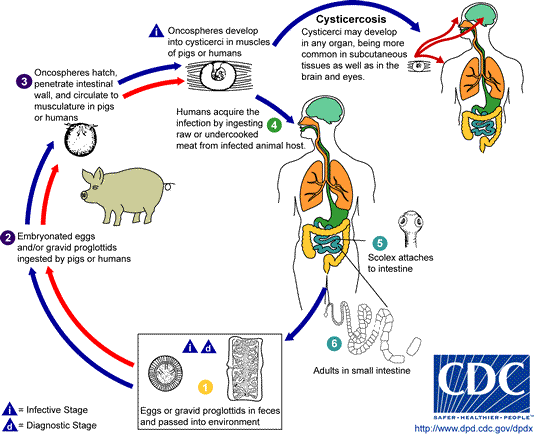| |
Cysticercosis is an
infection of both humans and pigs with the larval stages of the parasitic
cestode, Taenia solium. This infection is caused by ingestion of
eggs shed in the feces of a human tapeworm carrier
 .
Pigs and humans become infected by ingesting eggs or gravid proglottids .
Pigs and humans become infected by ingesting eggs or gravid proglottids
 . Humans
are infected either by ingestion of food contaminated with feces, or by
autoinfection. In the latter case, a human infected with adult T. solium
can ingest eggs produced by that tapeworm, either through fecal
contamination or, possibly, from proglottids carried into the stomach by
reverse peristalsis. Once eggs are ingested, oncospheres hatch in the
intestine . Humans
are infected either by ingestion of food contaminated with feces, or by
autoinfection. In the latter case, a human infected with adult T. solium
can ingest eggs produced by that tapeworm, either through fecal
contamination or, possibly, from proglottids carried into the stomach by
reverse peristalsis. Once eggs are ingested, oncospheres hatch in the
intestine  ,
invade the intestinal wall, and migrate to striated muscles, as well as the
brain, liver, and other tissues, where they develop into cysticerci. In
humans, cysts can cause serious sequellae if they localize in the brain,
resulting in neurocysticercosis. The parasite life cycle is completed,
resulting in human tapeworm infection, when humans ingest undercooked pork
containing cysticerci ,
invade the intestinal wall, and migrate to striated muscles, as well as the
brain, liver, and other tissues, where they develop into cysticerci. In
humans, cysts can cause serious sequellae if they localize in the brain,
resulting in neurocysticercosis. The parasite life cycle is completed,
resulting in human tapeworm infection, when humans ingest undercooked pork
containing cysticerci
 . Cysts
evaginate and attach to the small intestine by their scolex . Cysts
evaginate and attach to the small intestine by their scolex
 .
Adult tapeworms develop, (up to 2 to 7 m in length and produce less than
1000 proglottids, each with approximately 50,000 eggs) and reside in the
small intestine for years .
Adult tapeworms develop, (up to 2 to 7 m in length and produce less than
1000 proglottids, each with approximately 50,000 eggs) and reside in the
small intestine for years
 . . |
|
